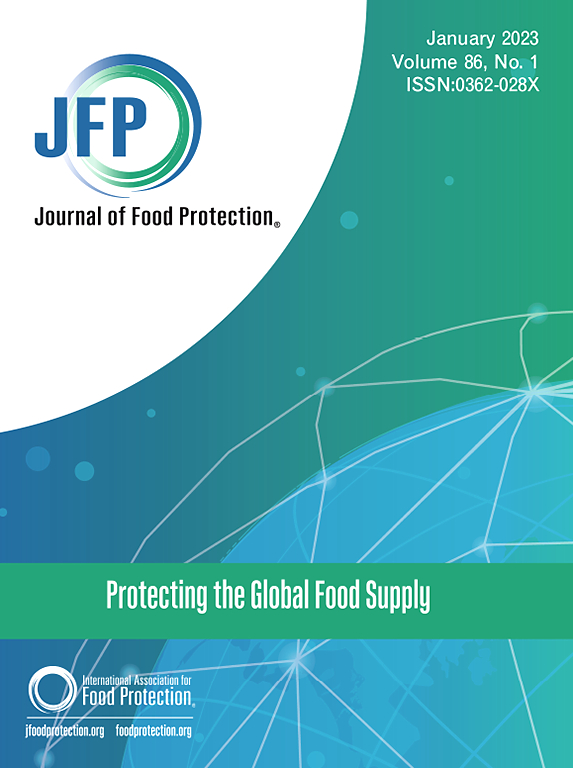Efficacy of a Novel Two-sided Drop-through Photonic Decontamination System on Salmonella and Campylobacter Reduction on Broiler Parts
IF 2.8
4区 农林科学
Q3 BIOTECHNOLOGY & APPLIED MICROBIOLOGY
引用次数: 0
Abstract
Antimicrobial intervention procedures are important in poultry processing to minimize foodborne pathogen contamination on raw meat. High-intensity pulsed light has been assessed as a novel alternative to currently used chemical antimicrobials in the poultry industry. The objective of this study was to evaluate the efficacy of a novel two-sided drop-through photonic decontamination system developed by PulseForge Inc. that employs pulsed light for reducing aerobic plate counts (APCs), Enterobacteriaceae (EB), Salmonella, and Campylobacter on whole wings and tenders. A total of eight individual repetitions were carried out, with the first five repetitions evaluating APC, EB, and Sal and the last three repetitions focusing only on Campylobacter. Treatments included an inoculated control (no treatment), pulsed light treatment (PL), 30 s water dip, 30 s water dip with PL, 30 s peracetic acid dip (PAA, 200 ppm), 30 s PAA dip with PL, three parts simultaneously with PL, and five parts simultaneously with PL. Parts were inoculated with either 105 CFU S. Infantis or Campylobacter, and each treatment was performed. Bacterial recovery counts were log-transformed and are reported as log10 CFU/mL. All treatments which included the application of pulsed light reduced APC, EB, Sal, and Campylobacter on both tenders and wings when compared to the inoculated control, with the exception of Campylobacter on tenders, which was not reduced. The addition of a pulsed light treatment combined with prior PAA dip resulted in additional bacterial reductions on tenders and wings for APC, EB, Sal, and Campylobacter, with the exception of Campylobacter on tenders. Additionally, even when multiple parts are sent through the pulsed light machine simultaneously, reductions were still achieved comparable to sending a single part through at a time. Overall, the use of pulsed light was able to reduce levels of microbial loads against pathogens commonly associated with raw poultry.
一种新型双面穿透式光子去污系统对肉鸡部位沙门氏菌和弯曲杆菌的去除效果。
抗菌干预程序在家禽加工中很重要,以尽量减少生肉上的食源性病原体污染。高强度脉冲光已被评估为禽业目前使用的化学抗菌剂的新替代品。本研究的目的是评估PulseForge公司开发的一种新型双面穿透式光子去污系统的效果,该系统利用脉冲光减少整个翅膀和鸡翅上的好氧平板计数(APC)、肠杆菌科(EB)、沙门氏菌和弯曲杆菌。共进行了8个单独的重复,前5个重复评估APC、EB和Sal,后3个重复仅关注弯曲杆菌。处理包括接种对照(未处理)、脉冲光处理(PL)、30 s水浸、30 s水浸、30 s过氧乙酸浸(PAA, 200 ppm)、30 s PAA浸PL、3份同时浸PL、5份同时浸PL。部分接种105 CFU s . Infantis或Campylobacter,每种处理进行。细菌恢复计数对数转化,报告为log10 CFU/mL。与接种对照相比,包括脉冲光处理在内的所有处理都减少了幼体和翅膀上的APC、EB、Sal和弯曲杆菌,但幼体上的弯曲杆菌没有减少。脉冲光处理加上先前的PAA浸液,导致除了弯曲杆菌外,APC、EB、Sal和弯曲杆菌在投标和翅膀上的细菌减少。此外,即使多个部件同时通过脉冲光机发送,仍然可以实现与一次发送单个部件相当的减少。总体而言,脉冲光的使用能够降低微生物负荷水平,以对抗通常与生家禽相关的病原体。
本文章由计算机程序翻译,如有差异,请以英文原文为准。
求助全文
约1分钟内获得全文
求助全文
来源期刊

Journal of food protection
工程技术-生物工程与应用微生物
CiteScore
4.20
自引率
5.00%
发文量
296
审稿时长
2.5 months
期刊介绍:
The Journal of Food Protection® (JFP) is an international, monthly scientific journal in the English language published by the International Association for Food Protection (IAFP). JFP publishes research and review articles on all aspects of food protection and safety. Major emphases of JFP are placed on studies dealing with:
Tracking, detecting (including traditional, molecular, and real-time), inactivating, and controlling food-related hazards, including microorganisms (including antibiotic resistance), microbial (mycotoxins, seafood toxins) and non-microbial toxins (heavy metals, pesticides, veterinary drug residues, migrants from food packaging, and processing contaminants), allergens and pests (insects, rodents) in human food, pet food and animal feed throughout the food chain;
Microbiological food quality and traditional/novel methods to assay microbiological food quality;
Prevention of food-related hazards and food spoilage through food preservatives and thermal/non-thermal processes, including process validation;
Food fermentations and food-related probiotics;
Safe food handling practices during pre-harvest, harvest, post-harvest, distribution and consumption, including food safety education for retailers, foodservice, and consumers;
Risk assessments for food-related hazards;
Economic impact of food-related hazards, foodborne illness, food loss, food spoilage, and adulterated foods;
Food fraud, food authentication, food defense, and foodborne disease outbreak investigations.
 求助内容:
求助内容: 应助结果提醒方式:
应助结果提醒方式:


